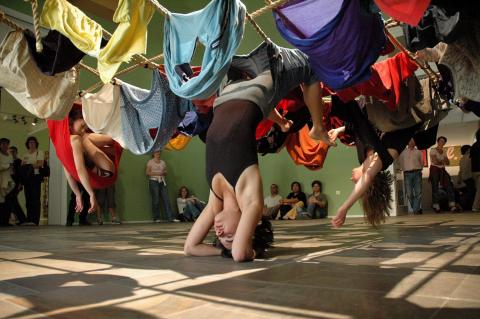
Dancing with the Images
If I’d ever stopped to think about it, I might have figured out what dance and drawing have in common. The similarity is not immediately apparent, but both art forms depend on composition, line, rhythm, focus, creativity, and an understanding of spatial relationships. Moreover, you don’t have to be an expert to enjoy dancing or drawing, or "Dance/Draw," the latest exhibition at the Institute of Contemporary Art (ICA).
The fact remains, however, that I never considered pairing dancing and drawing. Helen Molesworth did. The new chief curator at the ICA recognized the tie-in. Her first exhibition, “Dance/Draw,” on view through January 16, 2012, explores the evolving relationship between the visual arts and dance during the last 50 years.
“Dancing and drawing are forms of creativity that we are encouraged to participate in freely as children,” says Molesworth. “Many of us progressively withdraw … as we grow older, more self-conscious of our bodies, and increasingly self-critical of our skills.”
The ICA, which is celebrating its 75th anniversary this year, has cultivated a reputation for cutting edge exhibitions that quite literally open our eyes to innovative ideas. Often, they’re also fun The museum’s free birthday party on December 10 is its opportunity to plan activities around the Dance/Draw exhibition, musical performances, and gallery talks.
Dance/Draw, defines art and drawing broadly, if it bothers to define them at all. One artist, John Cage, in 1965 questioned the nature of drawing. “What is a drawing,” he asked, and concluded, “No one knows any longer.”
Molesworth's answer reduces drawing to its simplest elements. “A drawing.” she says, “is a group of lines assembled in various ways on the page.”
So it seems. Drawings in the first gallery explore images made by “more than just the hand.” David Hammons’s “Basketball Drawing,” for example, is made of impressions left by a ball bounced in Harlem earth and tossed against a vertically hung strip of white paper. Trisha Brown produced her drawing, “Untitled,” by fluttering mascaraed eyelashes against the paper. John Cage’s drawing, “Wild Edible,” is handmade paper showing the residue of milkweed, cattail, clover, saffron, pokeweed, and hijiki, a brown vegetable that grows wild along the coasts of Japan, Korea, and China.
Sometimes, it appears that a drawing doesn’t even need paper. In its own minimalist way, the line may exist in space as string or wire.
For many years, Ruth Asawa crocheted thread sculptures that hover in space, casting abstract forms on the ceiling and walls. In the early 1940s, when she was an art student at the experimental Black Mountain College in North Carolina, she was inspired by the dancers to create biomorphic forms.
The postmodern dance in this exhibition is just as inventive and challenges the dancers as well as the viewers. Photographs and video tapes show what is being done now. Trisha Brown Dance Company’s “Floor of The Forest,” which occupies one whole gallery, is described as “a sculpture, a prop for a dance, and a performance.” It consists of used clothes woven onto a metal armature. Two dancers independently wend their way in, out, and through the suspended clothing. Performances – no two are exactly the same -- are scheduled for Thursdays at 6p.m. and 8p.m, and Saturdays at 1p.m., 3p.m., and 4p.m.
I’m not sure exactly how Sadie Benning’s 20-minute film, “Play Pause,” fits into the show, unless it’s for the graphic drawings. But it’s a worthwhile addition and deserves to be seen.
The more than 100 exhibits featured in “Dance/Draw” include well-known as well as emerging artists from the Americas, Asia, and Europe. They point the way to the new directions contemporary artists are moving.

